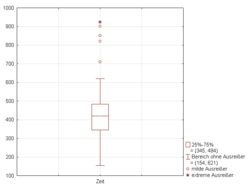Interquartile range
In statistics, the interquartile range (IQR) is a number that indicates how spread out the data are, and tells us what the range is in the middle of a set of scores.
The interquartile range IQR is defined as:[1][2]
- [math]\displaystyle{ \mathrm{IQR}=Q_3-Q_1 }[/math]
That is, it is calculated as the range of the middle half of the scores. The scores are divided into four equal parts, separated by the quartiles [math]\displaystyle{ Q_1, Q_2 }[/math] and [math]\displaystyle{ Q_3 }[/math], after the scores have been arranged in ascending order (becoming bigger as one goes further). The second quartile [math]\displaystyle{ Q_2 }[/math] is also known as the median.[3]
The interquartile range is not sensitive to outliers (scores that are much higher or much lower than the other scores). In fact, it eliminates them.
Example
Given the following 20 scores arranged from the smallest to the largest:
- 1, 2, 2, 2, 3, 4, 6, 8, 8, 8, 8, 8, 9, 11, 11, 14, 14, 15, 15, 29
We can put them into four different groups of five numbers each:
- 1, 2, 2, 2, 3 | 4, 6, 8, 8, 8 | 8, 8, 9, 11, 11 | 14, 14, 15, 15, 29
The groups are thus separated by:
- [math]\displaystyle{ Q_1=3{.}5,\ Q_2=8,\ Q_3=12{.}5 }[/math]
Hence the interquartile range is:
- [math]\displaystyle{ \mathrm{IQR}=Q_3-Q_1=12{.}5-3{.}5=9 }[/math]
If the observation 29 has accidentally been written down as 92 instead, then this number is an outlier. If that happens the interquartile range is not affected.
Interquartile Range Media
Boxplot (with an interquartile range) and a probability density function (pdf) of a Normal Template:Maths Population
Box-and-whisker plot with four mild outliers and one extreme outlier. In this chart, outliers are defined as mild above Q3 + 1.5 IQR and extreme above Q3 + 3 IQR.
Related pages
References
- ↑ "List of Probability and Statistics Symbols". Math Vault. 2020-04-26. Retrieved 2020-10-13.
- ↑ "InterQuartile Range (IQR)". sphweb.bumc.bu.edu. Retrieved 2020-10-13.
- ↑ "Interquartile Range: Definition". stattrek.com. Retrieved 2020-10-13.

